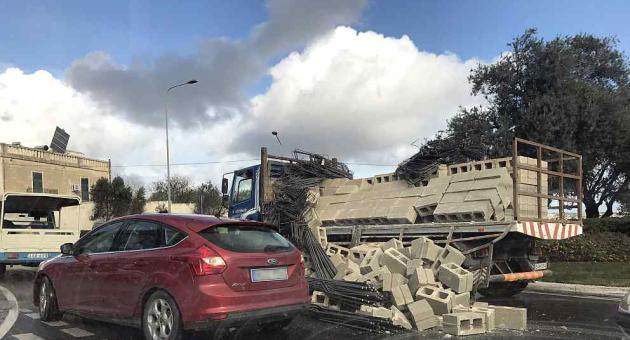Is your product packaging up to the transport task?
One of the common hazards to emerge when conducting CoR risk assessments of transport activities for manufacturers of goods is that of packaging integrity. There is a risk if the product packaging is not adequate the load could shift in transit and or cause the load restraint system to fail prematurely. In both cases the goods could dislodge from the vehicle and strike other road users or pedestrians resulting in serious injuries or fatalities–in the worst case scenario, see following.
Inadequate packaging leads to death of 3 children
“The method of restacking and banding was not sufficient to stop movement during travel.”
In 2003 Michelle Rose was driving south on the Stuart Highway in the Northern Territory. In the car were her three children (Jade, 8, Rory, 7 and Nathaniel, 2). Near the Edith River Bridge, her vehicle hit a metal track (grouser) plate on the roadway causing the vehicle to leave the road, roll over and sink in the river. All 3 children subsequently drowned. The grouser plates had fallen off a truck trailer after the load had settled and shifted. The coroner’s report2 stated, “The method of restacking and banding (the grouser plates) was not sufficient to stop movement during travel.”
What’s required by law?
The loading requirements in the Heavy Vehicle (Mass, Dimension and Loading) National Regulations (HV(MDL)NR) require a load must not be placed in a way that makes the vehicle unstable or unsafe and must be secured so it is unlikely to fall or be dislodged from the vehicle. The load includes “all the goods”, such as packaged goods.

Furthermore, the HV(MDL)NR requires an appropriate method must be used to restrain the load on a heavy vehicle. The National Transport Commission (NTC) Load Restraint Guideline indicates packaging can be used as part of the load restraint system provided it is of sufficient strength to withstand the forces indicated by the loading performance standards3–see Figure 1.
Fundamentally what this all means is that, the packaging together with the applied load restraint method need to ensure the load remains secure during travel, heavy braking and if subjected to a crash force equivalent to a heavy vehicle and light vehicle collision.
For the purpose of this article, the focus is on packaged goods that require restraint by tie-down lashings or blocking or a combination of both.
What is packaging and packing?
Packaging, as defined in s5 of the HVNL, means anything that contains, holds, protects or encloses the goods, whether directly or indirectly, to enable them to be received or held for transport, or to be transported. In simple terms, something that holds the goods together, for example, goods stretch wrapped to a pallet or goods contained within a drum.
Packing is basically the “act” of packaging. Packing as defined in the HVNL as ‘pack and packer’, means putting goods in packaging, even if that packaging is already on the vehicle, for example–palletising finished goods or packing goods into a tanker such as bulk liquids.
It also means assembling the goods as packaged goods in an outer packaging, even if that packaging is already on a vehicle. Outer packaging means a packaging that forms the outer protection, for example–pallet cartons or wooden cases.
For the purpose of this article, the focus is on packaged goods that require restraint by means other than containment, typically being packaged goods restrained by tie-down lashings or blocking or a combination of both, and not bulk goods in tippers or tankers.
Did you know?
There is in effect the role of ‘Packing manager’ under the HVNL?–similar in concept to the defined role of Loading manager. If you look closely at the definition of Packer in s5 of the HVNL, you will see it includes a person who supervisors packing activities, or, manages or controls packing activities. So, whilst packing manager is not explicitly defined in the HVNL, it is implicit in the definition of packer. Are you a Packing manager?
So how do you know if your packaging is up to the transport task?
Well, firstly we’ll flip this question on its head. You know that your packaging IS NOT up to the transport task if there is any evidence of the packaged goods shifting in transit (throughout the journey) or moving after a heavy braking event or collision. This is an indication the packaging is not of a sufficient strength (or the load restraint system is not appropriate). But it is never a good idea to wait for an event to occur to test the adequacy of packaging, which may be evidence of a breach of the law, not to mention the risk it creates.
On the other hand, it might be considered that an absence of incidents may be an indication the packaging strength is sufficient, or it might just be good luck rather than good management. Either way, this is not a reliable indicator of the absence of future events and should not be relied upon as evidence of compliance, as it may provide a false sense of security.
Three ways you can validate your packaging is up to the task are:
- Supplier Specifications
Consult with the supplier of the packaging systems (materials, tools and equipment) to confirm the packaging requirements for your particular situation. Seek evidence of the specifications/certification of the packaging systems such as the strength and or load limit, the quantity required for a given weight or configuration, for example, the number of layers of stretch or shrink wrapping, the number and orientation of packing straps, or the volume of glue etc.
- Static Tilt Test
Conduct a static tilt test that simulates the forces described in the loading performance standards–see Figure 1. A static tilt test involves tilting (tipping) the packaged goods to an angle from horizontal to generate a force on the load. For example, tilting the load to 30 degrees from horizontal simulates a 0.5g force, similar to the lateral (sideways) and rearward forces in the performance standards. The tilt test can be performed with and without the load restraint applied–see Figures 2 and 3.
In the case of palletised goods, the goods can be tilted on the pallet itself, or the pallet can be placed on a tilting device. Depending on the packaging arrangement the goods may need to be tested in different orientations i.e. rotated through 90 degrees.
For more guidance on static tilt tests it is recommended you contact a suitably qualified professional. And always make sure there is an exclusion zone in place to protect all people involved.
- Dynamic Braking Test
Conduct a controlled braking test that aims to generate the forces described in the loading performance standards. A dynamic braking test involves loading and restraining the packaged goods on a heavy vehicle and performing a harsh emergency braking (hitting the brakes as hard as you can). Simulated braking tests are typically used to test the entire load restraint system, not just the packaging itself.
Note these tests are much more involved than the previous two methods and should be undertaken under the guidance of an experienced engineer. For one thing, a fail-safe system to protect the driver of the vehicle if the load restraint system doesn’t work as planned.
Three risk factors to consider when packing goods include:
- Slippery Surfaces
Make sure interlayer packing that is placed between layers of goods or on the base pallet is not a slippery (low friction) material. Do not use slip-sheets or slippery plastic for interlayer packing. This can cause the packaged goods to slip and slide underneath the tie-down lashings.
Avoid steel on steel contact, such as steel banding contacting a steel truck tray. Use rebated timber dunnage if strapping dunnage to the goods. - Loose Items
Make sure individual items cannot work loose and dislodge from their packaging, such as individual cartons or blocks from a pallet of goods. This includes items that may be prone to settling in transit, like the steel track plates in the incident above.
Also make sure loose items from within a pack cannot spear out, such as lengths of steel or timber in centre of a bundle. - Tall, Skinny Items
There is a risk tall, skinny items may topple over when braking or cornering. Make sure the length and width of packaged goods provide a stable base in proportion to the height of the goods, otherwise block or secure the goods together to increase their stability. For more specific advice on making sure the load is stabilised refer to page 16 of the NTC Load Restraint Guide 2018.
In summary, in addition to making sure the packaging is of sufficient strength, blocking should be used wherever possible when restraining packaged goods with tie-down lashings. Also consider containing loads with load rated side gates, or within curtain sided vehicles with gates, or load rated curtains, to reduce the risk of packaged goods dislodging from the vehicle.
For more information it is recommended you refer to the NTC Load Restraint Guide 2018 which provides guidelines on how you can meet the loading performance standards when restraining packaged goods. It also covers many of the risks and controls identified in this article in greater detail.
SCSE Director and Principal Consultant, Sean Minto is the technical writer of the Master Industry Code of Practice and an experienced risk, safety and compliance professional–if you require assistance checking your product packaging is up to the transport task, please get in touch.
- http://www.independent.com.mt/articles/2017-01-16/local-news/No-one-injured-as-concrete-blocks-and-metal-rods-fly-off-back-of-truck-in-Zebbug-6736169111
- Coroner’s Court, Darwin, Inquest into the death of Jade Marie Lange-Loades, Rory Duncan Lange-Loades and Nathaniel Jake Rose [2004] NTMC 074, 1 October 2004.
- National Transport Commission, Load Restraint Guide 2018, Third edition, 2018, p.177.
Disclaimer
The information provided in this article is designed to provide helpful information on the subjects discussed. SCSE cannot be held liable for any inaccuracies or omissions in this article. You should seek appropriate advice from an experienced engineer for your own situation.


